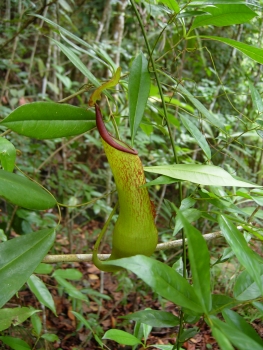Mount Hamiguitan

The Mount Hamiguitan Range Wildlife Sanctuary is a diverse mountain ecosystem with a high number of endemic plant and animal species.
The mountain range is home to a number of globally threatened and endemic species, such as the critically endangered Philippine Eagle and the tropical pitcher plant Nepenthes hamiguitanensis. It lies in a semi-isolated area in the south of Mindanao Island, which has led to a high level of endemicity.
Community Perspective: Hamiguitan’s visitor center can be visited as a day trip from Davao, the park itself is a strict reserve that only sparsely allows scientists and climbers (permit only).

Map of Mount Hamiguitan
Community Reviews
Clyde

I visited this WHS in Spring 2025. The big international car rental companies are now available near Davao airport. For the time being (till the airport enlargement works are completed), you are greeted upon arrival (excellent communication via email and whatsapp prior to arrival) and a shuttle takes you to the car rental office in Davao. This will make you waste at least 30 minutes to 1 hour in total as getting in and out of the city is slow with heavy traffic at most times of the day.
Since we were arriving quite late in Davao, we decided to visit the Philippine Eagle Sanctuary/Centre first (which is not part of the WHS but we wanted to support their invaluable work and make sure to see this magnificent bird). It is a good 1.5 hours drive to get there and 4 hours away from the Mount Hamiguitan Natural Heritage Museum or Visitor Centre. A good resort near the sanctuary is the Malagos Garden Resort with its own bird show (no Philippine Eagles here), butterfly garden, etc. and a must stopover point if you'd like to taste and buy the excellent Malagos chocolate.
Something to keep in mind when in Mindanao is that when it rains here, it really pours, as can be clearly seen with all the flood advisories along the roads. This is why we didn't want to risk it, so we drove to the visitor centre immediately after visiting the eagle centre and arrived after sunset. The roads overall were in very good condition and no 4x4 car is necessary in sunny weather. For the night we stayed at the Mount Hamiguitan Longhouse Lodge (which has its own UNESCO "plaque" at the reception although it is not in the core zone. Already at 408 metres above sea level, it is known as the "Jump Off Area" or simply the start off point from where permit holders start one of the 3 trails to the summit of Mount Hamiguitan. The Mount Hamiguitan Escape Resort was still closed during my visit, although a small bar selling local beer and Mt Hamiguitan corn brew coffee, as well as the pool, were open.
Just before the sharp turn leading to the Mount Hamiguitan Nature Heritage Museum, we spotted 2 UNESCO WHS information board type plaques, before reaching the parking lot with a proper UNESCO WHS plaque. The uppermost are of the mountain is frequently covered in clouds of mist and fog, especially in the morning, although we were lucky to spot the summit in the afternoon from Pujada Bay (proposed tWHS extension). Armed with binoculars and a zoom lens, I spent some time at the area with hairpins leading up to the museum, mostly to spot at least one of the 400 pairs of critically endangered Philippine eagles left in the wild (takes only one mate for life and lays only one egg every two years!). Although the area is designated as an Important Bird Area, it was more an exercise of bird spotting rather than proper birdwatching, which is why I'm still glad we made the effort to visit the eagle centre. We also spotted (impossible to take good photos) a pair of rufous-lored kingfishers (due to the proximity of a watershed), the unmistakable Mindanao bleeding heart, some cockatoos, Jerdon's baza, Philippine coucals, Philippine bulbuls, Mindanao hornbill, coletos, flowerpeckers, and a yellow-bellied whistler.
The Mount Hamiguitan Nature Heritage Museum and their helpful staff provide useful information to help appreciate this unique mountain range and some of the highlights it offers in terms of flora and fauna. Around the museum area, you'll definitely be able to see the endemic pitcher plants, orchids, lots of ferns, some pygmy trees and plants, butterflies, as well as lots of critters (orb weavers, giant ants, beetles, etc.). Obviously, we followed Thomas Buechler's instructions and reached the core zone after quite an uphill hike which took us less than an hour from our lodge, but if truth be told it didn't add much to our overall short visit, apart from feeling more fully immersed in nature with louder bird calls and non-stop insect activity (luckily no mosquitoes or leeches when we visited). In the upper floor of the museum/visitor centre, you'll also find the UNESCO WHS inscription certificate proudly displayed.
Mount Hamiguitan's summit is not that high at 1,628 metres above sea level. That said, after getting a permit individually or by joining others on a tour (taking place mostly on weekends), there are 3 trails to the summit which will take roughly 11 hours of uphill hiking over 2 nights (camping) and 3 days: the shortest but hardest being the La Union - San Isidro trail with some steep ravine climbing and the La Union river crossing involved, passing by Lantawan where large colonies of pitcher plants in varying sizes are observed; the easy to average Magum - Mati trail which offers many picturesque spots (Magum Lookout, Camp Jabar, Hidden Garden, Tinagong Dagat, Mossy Forest and Lantawan Magum) with a gradual ascent; and the average Domagooc - Governor Generoso trail which is the longest and follows the Domagooc river, passing by Domagooc Falls and Twin Falls before reaching Camp 3 at the Pygmy Forest. Most of these named places have a UNESCO WHS information board plaque of some sort.
Even if you don't reach the mountain's summit, the most important thing to observe and appreciate this site's OUV is definitely the presence of five vegetation types: brushland, dipterocarp forest, montane forest, mossy pygmy forest, and mossy forests. This shows the high variability of characteristics of the area, and despite the challenges brought about by certain environmental conditions such as ultramafic soil (igneous rock soil highly enriched in metals and depleted in plant nutrients).
The Bonsai Forest or Pygmy Forest is found at the topmost part of the mountain range and occupies approximately 1234.56 hectares (quite easy to remember from the museum's staff explanation) of the sanctuary. The stunted growth of trees (at an average height of 1.4 metres) could be attributed to the high concentration of cobalt, iron, nickel and magnesium in the soil. This ecosystem is a frontier for scientific research on the flora and fauna that thrive in such an environment.
Mount Hamiguitan hosts a whopping 957 recorded species of flora (ex. orchids, ferns, lichens, mosses, epiphytes, bryophytes, pygmy trees, pitcher plants) and 423 recorded species of fauna (ex. monkeys (long-tailed macaques and tarsiers), Philippine warty pig, monitor lizards, frogs, beetles (ex. Mystroceros rouyeri in photo), spiders, rodents (such as the endemic hairy-tailed rat), venomous snakes, stick insects, butterflies (we saw plenty of different and colourful species fluttering and mating when we visited), fireflies (easy to spot at night from the lodge), colonies of other critters (giant ants, bees, termites, etc.), birds (kingfishers, babblers, bulbuls, the Mindanao bleeding-heart dove, the Philippine cockatoo, the majestic Philippine eagles, hawk-eagles, eagle owls, etc.)). 6 flora (3 pitcher plants (such as the famous Nepenthes hamiguitanensis), 1 orchid, 1 hoya plant) and 6 fauna (4 butterflies, 1 rodent and 1 roundworm) species are now considered endemic to Mount Hamiguitan.
We really enjoyed our short visit to this natural WHS and after our visit we also covered the proposed extension of Pujada Bay which although quite ambitious (especially with the nearby fish farming practices) could truly extend this WHS so as to cover more vegetation types from below sea level to the mountain's summit.
Thomas Buechler
Mount Hamiguitan is difficult to reach by public transport as it involves several changes of buses/minibuses or jeepneys; but the good news is that nowadays it is possible to rent a car right at Davao airport, unlimited kilometers at a reasonable rate. Then, it is 3-4 hours drive to the visitors center which was closed for renovation, but it is possible to take the Heritage trail and see parts of the forest from viewpoints. This is not part of the core zone, and so is the nearby Hamiguitan Escape Resort with an amazing pool; it was also closed, but the pool was very welcome in this tropical climate. Uphill there is the Longhouse lodge with friendly owners. Here hikers stay overnight, it is the base camp for the Mount Hamiguitan climbers, the lucky ones with the permits. To have a short experience inside the core zone, ask around with the locals, Corner 17 is one of the entry points; Mount Hamiguitan was also declared an ASEAN Heritage park.
Zoë Sheng
Chinese-Canadian - 03-Aug-18 -

Hamiguitan is a good 3½h by jeepney from the nearest town Davao. It is not an easy journey and you also need to ensure the driver drops you off at the junction to the visitor center and then still take a tricycle for the rest of the way. As accommodation is limited I recommend doing this really early morning and going back to Davao in the afternoon already. I can see why this is not of the more visited places as Mindanao is still considered somewhat unsafe in the southwest and tourism has almost nothing going on here. I also looked into renting a car but there is nothing.
Once you finally make it to the visitor center you can pay a puny entrance fee for a pretty good museum. The core zones of the national park are offlimit to regular visitors. No permit - no hike. No guide - no hike. You can do some small hikes around the sanctuary to see something but the good stuff will stay hidden from us tourists. If you want to see the Philippine Eagle you need to go to the Eagle Center north of Davao which I used as a picture.
I also wonder what happened to the proposal to add Mt. Apo into this inscription as this is another fine destination around Davao.
Boj

In, 2010, Mt. Hamiguitan was closed to visitors in preparation for its bid to UNESCO World Heritage inscription. During a recent hike (July 2012), the protected area has shown positive signs of recovery. The mountain is indeed a biodiversity/endemism hotspot; its bonsai forest is just one of the many outstanding features of the property.
Also worth noting is the tireless and collective efforts of the concerned local government units in ensuring the protection of the park. Such a practice is rare in the country and very inspiring.
Community Rating
Site Info
- Full Name
- Mount Hamiguitan Range Wildlife Sanctuary
- Unesco ID
- 1403
- Country
- Philippines
- Inscribed
- 2014
- Type
- Natural
- Criteria
-
10
- Categories
- Wildlife habitat - Flora
- Link
- By ID
Site History
2014 Inscribed
2013 Referred
2013 Advisory Body overruled
Deferral was proposed
2012 Incomplete - not examined
2012 Revision
Includes part of former TWHS Mount Apo and Mount Hamiguitan: Sanctuaries of Endemism in Mindanao (2008)
2010 Incomplete - not examined
As part of former TWHS Mount Apo and Mount Hamiguitan: Sanctuaries of Endemism in Mindanao
Site Links
Unesco Website
Related
In the News
Connections
The site has 20 connections
Ecology
Geography
Human Activity
Visiting conditions
WHS Names
WHS on Other Lists
World Heritage Process
Visitors
15 Community Members have visited.
The Plaque
 (photo by Clyde)
(photo by Clyde)